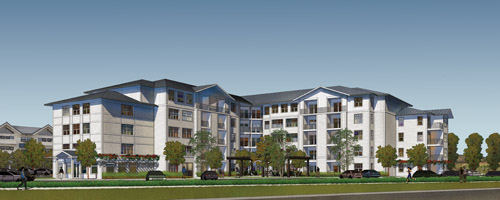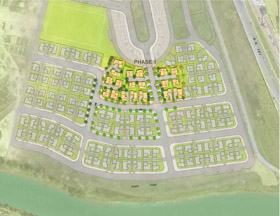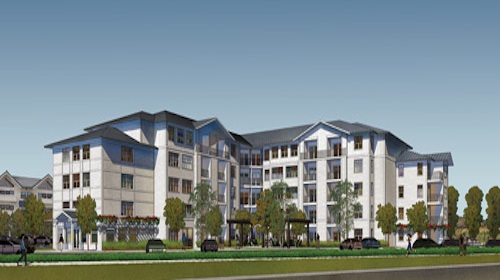
As you drive northbound through the beautiful rolling hills of Marin County and southern Sonoma, Highway 101 takes you around one more turn and the grand view of the City of Petaluma opens up in front of you. Petaluma is a transliteration of the Coast Miwok phrase péta lúuma, which means hill backside. No matter which direction you view Petaluma from, the name is as obvious as the city is attractive.
The view of Petaluma early in the morning from the top of the Cotati grade, as the pink clouds are under lit by the rising sun in the east and a thin layer of morning fog blankets the surrounding fields, is arguably amongst the most spectacular views in the North Bay. The southern gateway into Petaluma, as you cross the Petaluma River with the Marina on your right, is the location of several new housing and living developments that will bring much needed residential units and capacity to a city where the housing demand is in the process of outmatching supply. We all know about the devastation brought on by the wildfires, and subsequent urban fires, in October. While Petaluma was not directly affected, the loss of thousands of homes in Sonoma, Napa and neighboring counties, and perhaps in the city of Santa Rosa in particular given the close proximity to Petaluma, puts further pressure on the local housing market. Over the course of just a few days, the demand for permanent as well as temporary housing took a very unfortunate and unforeseen leap. A leap that no one could have predicted, adding stress to the already tight residential housing situation in the North Bay.
According to the 2017 Petaluma Local Economic Profile, presented by the Sonoma County Economic Development Board, in partnership with the City of Petaluma, and the Petaluma Area Chamber of Commerce, the Petaluma residential housing vacancy is exhibiting a drastic tightening trend. Rental vacancy rates went from a peak of 7 percent in 2011 to 2.2 percent in 2015. Meanwhile, homeowner vacancy rates, already at critical low, fell from 1.6 percent in 2009 to 1 percent in 2015. (Real estate analysts generally consider 3 percent as full occupancy in the housing market.) Accordingly, the median home prices in Petaluma continue to trend upward since recovery started in 2011 and are approaching the peak levels of 2005 to 2007.
Petaluma River
Rivers are often a central focal point in many of our nations great cities. And riverfront developments continue to thrive in the spirit of using the river as a central gathering ‘spine’ and linchpin between a multitude of activities around residential living, tourism, commerce, entertainment, dining, outdoor living, recreational use of the water, sports and more. Petaluma is most certainly one of these cities with its river, and a few others in the North Bay and beyond include Napa, Sacramento, West Sacramento and Reno.
With the occupancy levels generally back to, or beyond the pre-2007 recession levels, the new developments around Petaluma’s southern entryway along the river will not singlehandedly solve what is currently being described as a housing crisis due to a significant shortage of rental and ownership entities. However, these developments will provide hundreds of new residences in the form of single-family homes, townhomes and apartments. Nearly 200 hotel rooms will also be added, contributing to a noteworthy upswing not only to housing availability but also to the local economy, providing new jobs in construction and housing management, while generating fresh city revenues.
The Riverfront Development
The Riverfront Development is a large project that is located on the land off of Hopper Street between Lakeville Street and the Petaluma River. It’s currently in the early stages of infrastructure development under the management of Basin Street Properties. “The Riverfront is a 39-acre mixed-use development with 134 single family homes, 39 townhomes, a 122 room Courtyard by Marriott hotel, a 60,000- square-foot office building and two buildings that have a total of 100 apartments above commercial space,” says Paul Andronico, representative and spokesperson for Basin Street Properties.
Lakeville Street and the Petaluma River. It’s currently in the early stages of infrastructure development under the management of Basin Street Properties. “The Riverfront is a 39-acre mixed-use development with 134 single family homes, 39 townhomes, a 122 room Courtyard by Marriott hotel, a 60,000- square-foot office building and two buildings that have a total of 100 apartments above commercial space,” says Paul Andronico, representative and spokesperson for Basin Street Properties.
In light of the October wildfires, Basin Street hopes to get the hosing units at Riverfront to market as soon as possible to help meet the desperate need for housing following the destruction of thousands of homes in Sonoma County from the recent wildfires. “While devastating, the fires showed the tremendous strength of people—and sense of community—in Sonoma County. Regular people provided support in many different ways, helping neighbors and strangers alike, firefighters put their lives on the line each day to save lives and property, and doctors and nurses saved lives while their homes were burning,” says Andronico.
The development includes a 3.25 acre passive use riverfront park, a 2.25 acre active use community park/soccer field, a donated site for a community boathouse adjacent to the river and bike paths along the perimeter of the property with a future bike path connector underneath the Highway 101 bridge to the Petaluma Marina. Andronico, a founding board member of the Housing Land Trust of Sonoma County, which helps to provide permanently affordable workforce housing in Sonoma County, is excited about the added value that the Riverfront project will bring to Petaluma and its residents.
“The city commissioned a fiscal and economic impact study on the Riverfront project which estimates more than $600,000 of net new annual city revenues, in large part due to the transient occupancy tax generated by the Marriott Courtyard hotel,” says Andronico. “The same impact study forecasts that the Riverfront project will create more than 500 new permanent jobs as well as more than 1,900 new temporary construction jobs. While the economic and social viability of any development is of great importance, at Basin Street Properties we find it equally significant that our developments are mixed-use when feasible, and such is certainly the case with the Riverfront project.”
This is the first major development in the ‘lower reach’ of Petaluma, and Basin Street Properties is creating significant public access opportunities along the river, including park areas that don’t exist today, as well as future boating opportunities and bike connectivity to the Petaluma Marina, something Andronico is proud to point out. “Petaluma prides itself on its pedestrian and bike access, as well as its relationship to the Petaluma River. The Riverfront Development meets multiple community needs and hits home in all these areas with a focus on public parks, bike paths, the inclusion of a variety of housing types, and allowing for residents to live and work in the same community and neighborhood.”
Project timeline
Work on The Riverfront Development is actively underway for both off-site and on-site infrastructure developments, including the new main road and utilities. The infrastructure work is expected to be completed in the fall of 2017, allowing other project components to fall in line as quickly as the market will allow. According to Andronico, the specific schedules and time estimates for the construction of the single-family-homes, townhomes, central mixed-use buildings [apartments over commercial space], and office space, will be worked out and finalized with the merchant builders acquiring each of the project components, and will align with the market conditions.
The roughly 74,000-square-foot Courtyard by Marriott Hotel segment of the development will feature an outdoor swimming pool and spa, more than 200 shared parking spots, ample bicycle parking and a café. “The hotel’s design was created in collaboration with the City of Petaluma staff, and incorporates a number of unique architectural details, including a rotunda at the southeasterly corner of the building and a high degree of articulation both vertically and horizontally,” says Andronico. The design, which includes the latest in lobby design with a large, open, co-working space to foster collaboration, has been fully vetted and approved by the City. “The hotel site is under contract to be sold to a hotel developer and we anticipate construction to be under way in 2018 with opening of the doors to the 122 guest rooms in 2019,” says Andronico.
The Marina Apartments
Directly across Highway 101 from the Riverfront Development, is the Marina Apartments project, located within the existing Petaluma Marina development. The Marina Apartments is a 90-unit apartment building that is five stories high. It’s adjacent to the Sheraton Sonoma County Petaluma Hotel that is located on Marina Avenue. The building complex will feature a combination of rental units ranging from studios up to three bedrooms, with each unit having its own associated parking space or spaces. Basin Street Properties is the developer for the Marina Apartments as well. Says Andronico, “The building will include secure, indoor storage space for small watercraft such as kayaks and stand up paddle boards for the residents, given the proximity to the river and the public boat launch. This project, and the addition of residential use of the Petaluma Marina, will provide much-needed housing supply to the city and add additional mixed-use elements complimenting the existing office, hotel, and recreational uses of the marina.”
The notion of mixed-use will be further highlighted as the various pieces of the Riverfront project begin to materialize with the welcome addition of public parks, bike paths and commercial properties. The Marina Apartments is currently under construction with leasing and occupancy anticipated to begin in late 2018.
The Hampton Inn
A short distance up north on Lakeville Street, and close to downtown Petaluma, the iconic Silk Mill building, which was granted National Historic Landmark status in 1986, is currently undergoing the last phase of renovation and will shortly open its doors to locals and travelers as Petaluma’s new Hampton Inn Hotel. This restoration and transformation project is under the management and guidance of BPR Properties.
“This project has been extremely exciting for us to work on. It’s not every day that you get to start with an 1892 former silk mill building and historic landmark, and have the opportunity to convert it into a 75 room hotel,” says Perry Patel, partner at BPR Properties. “As a matter of fact, one of the focal factors for us when assessing a potential project is finding distressed assets that we can bring back to its original splendor. Buildings such as this give us so much to work with and allows for striking that perfect balance between the modern amenities that our customers have grown accustomed to while preserving and highlighting the history and beauty of the building.”
The restoration of the building started in the summer of 2016 after BPR secured the appropriate approvals from the City of Petaluma and the city’s Historical Board. Patel explains that the second major milestone in this undertaking was completing a tremendous amount of structural work in the building to have it seismically refitted. “As all of the structural work was completed, we restored the exterior of the building as best as possible to its original condition. Relative to the interior, we have also done everything we can to preserve the original look and feel of the building,” says Patel. The original external facing brick walls can still be found in the guest rooms and the original ceiling heights are still intact. Also restored are the wooden columns on the first floor.
One of the challenges BPR faced was trying to preserve the open space concept while still being able to furnish a 75-room hotel. Patel is confident that BPR was successful in that regard. Other design elements reflecting the desire to preserve the uniqueness of the building include showcasing the original staircase as an integral part of the hotel and embracing the original wooden style of the building’s windows in many public spaces, such as the breakfast room. During the construction of the hotel, BPR Properties has worked with several local sub-contractors, many of whom have personal connections with the Silk Mill building. Patel can think of at least a dozen or so folks involved in the reconstruction effort who have stories to tell about their families and ties to the property. “That makes the project a success to us, even before the hotel is opened,” he says.
Patel further expands on why this project was such an attractive fit for BPR Properties by explaining how well it aligns with BPR’s development approach. “In addition to the attractiveness of the building itself, we look for markets that are diversified with strong corporate travel as well as weekend business. In looking at Petaluma the occupancies are strong throughout the year for both weekdays and weekends. Additionally, we feel we’re filling a current void in Petaluma with a proven brand property close to downtown for our ‘road warrior business travelers’ while the property simultaneously bridges the gap between downtown and the waterfront.” The Hampton Inn Petaluma is targeting to open for customers on December 13.
Moving forward
The city of Petaluma has a rich history to be proud of, and is perhaps mostly known across the nation as the “The Egg Basket of the World” as well as the “Arm-Wrestling Capital of the World” (or wrist-wrestling as was the original phrase). Perhaps a lesser known, but much related fact is that with egg production and egg prices being at their peaks in the 1920s, for nearly two decades there was more money on deposit in Petaluma banks, per capita, than in any other town in the nation, and that the prosperity in Petaluma at the time sparked a spectacular building boom throughout the city. Then about half a century later, residential building permits again soared and the population of Petaluma almost doubled during a 10-year period in the 1960s. Under the stated objective of ensuring orderly growth and preserving the city’s small town character, in 1971 the city enacted the “Petaluma Plan,” limiting the number of building permits and promoting controlled growth. While the Petaluma Plan that originally attracted national attention has since been abandoned, the city, like most of our North Bay communities, is again struggling with an imbalance between housing demand and housing availability. Tragically, the lack of available rentals and homes for purchase became even more apparent following the Northern California fires, when thousands of displaced individuals and families struggled to find replacement housing.
deposit in Petaluma banks, per capita, than in any other town in the nation, and that the prosperity in Petaluma at the time sparked a spectacular building boom throughout the city. Then about half a century later, residential building permits again soared and the population of Petaluma almost doubled during a 10-year period in the 1960s. Under the stated objective of ensuring orderly growth and preserving the city’s small town character, in 1971 the city enacted the “Petaluma Plan,” limiting the number of building permits and promoting controlled growth. While the Petaluma Plan that originally attracted national attention has since been abandoned, the city, like most of our North Bay communities, is again struggling with an imbalance between housing demand and housing availability. Tragically, the lack of available rentals and homes for purchase became even more apparent following the Northern California fires, when thousands of displaced individuals and families struggled to find replacement housing.
These days there are positive signs for economic growth once again in Petaluma. The 2017 Petaluma Local Economic Profile issued by the Sonoma County Economic Development Board, shows that Petaluma’s unemployment rate is lower than that of other places in Sonoma County and that the median household income is expected to grow by more than 12 percent between 2016 and 2021. It’s anticipated that the trend of having fewer households in the lower income brackets will continue as well. While these are good economic signs, a more housing market specific growth indicator for Petaluma is that the value of building permits continues to climb. According to the 2017 Petaluma Local Economic Profile, this indicates strong growth in construction activity, which fuels economic growth, and thus has the potential to alleviate pressure on the housing market.
Residents and tourists both have a lot to look forward to in the near future with the new developments in Petaluma. The emergence of the Riverfront Development, the Marina Apartments and two new hotels may be just a start. For a city that takes great pride in its history and its relationship with the river, the emergence of the new southern gateway with easy pedestrian and bike access to riverfront activities, provides much needed residential housing and living opportunities for the growing population of residents, and also a place where visitors can experience the joys of this restorative environment.




